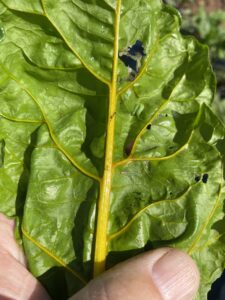Sweet Corn
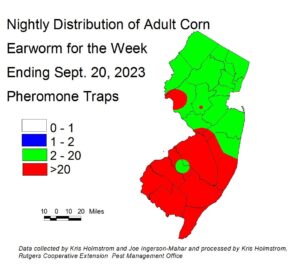 Northern and central blacklight traps and all pheromone traps continue to catch corn earworm (CEW) moths, although recent night temperatures in the low 50s have depressed numbers somewhat this week. Pheromone trap information is available from all northern and central sites, with now very limited input from southern New Jersey. We will use a combination of pheromone and blacklight trap types to derive silk spray schedules by region. We are now only able to check many traps on a weekly basis, as our student help has returned to their studies. This can give some areas an artificially high or low appearance of activity. Nonetheless, very high pheromone trap catches continue into Morris County. Red areas on the pheromone trap map (at upper right) indicate a 3-day spray schedule. Although the green areas indicate a 4 day schedule, blacklight trap catches in those areas remain consistent with a 3-day schedule. This is reflected in the suggested spray schedules below. Cool evening temperatures may further suppress activity temporarily. If this occurs and trap types are in agreement, more relaxed silk spray schedules may be suggested. Silking corn is at high risk of CEW infestation at this time. Be sure to access information from this publication in the upcoming weeks to determine how frequently you should treat silking sweet corn to protect it from CEW infestation.
Northern and central blacklight traps and all pheromone traps continue to catch corn earworm (CEW) moths, although recent night temperatures in the low 50s have depressed numbers somewhat this week. Pheromone trap information is available from all northern and central sites, with now very limited input from southern New Jersey. We will use a combination of pheromone and blacklight trap types to derive silk spray schedules by region. We are now only able to check many traps on a weekly basis, as our student help has returned to their studies. This can give some areas an artificially high or low appearance of activity. Nonetheless, very high pheromone trap catches continue into Morris County. Red areas on the pheromone trap map (at upper right) indicate a 3-day spray schedule. Although the green areas indicate a 4 day schedule, blacklight trap catches in those areas remain consistent with a 3-day schedule. This is reflected in the suggested spray schedules below. Cool evening temperatures may further suppress activity temporarily. If this occurs and trap types are in agreement, more relaxed silk spray schedules may be suggested. Silking corn is at high risk of CEW infestation at this time. Be sure to access information from this publication in the upcoming weeks to determine how frequently you should treat silking sweet corn to protect it from CEW infestation.
The highest nightly blacklight trap catches of CEW for the week ending 9/20/23 are as follows:
| Georgetown 12 | Allentown 4 | South Branch 3 |
| Hackettstown 8 | Hillsborough 4 | Chester 2 |
| Princeton 8 | Lawrenceville 3 | Dayton 2 |
| Bellemeade 5 | Oldwick 3 | Pennington 2 |
The highest nightly pheromone trap catches of CEW for the week ending 9/20/23 are as follows:
| Woodstown 88 | Green Creek 25 | Farmingdale 10 |
| East Vineland 60 | Sparta 22 | Matawan 9 |
| Georgetown 46 | Chester 20 | Berlin 8 |
| Snyder Farm (Hunterdon) 33 | Califon 14 | Dayton 6 |
Silking Spray Schedules*:
South – 3 days
Central – 3 days
North – 3 days
*These recommendations are based on regional catches. Adhere to tighter spray schedules if indicated by local trap catches. Synthetic pyrethroids alone should NOT be used for corn earworm (CEW) protection on silking corn, or for fall armyworm (FAW) management at any stage. Control with these materials is very inconsistent.
Cole Crops
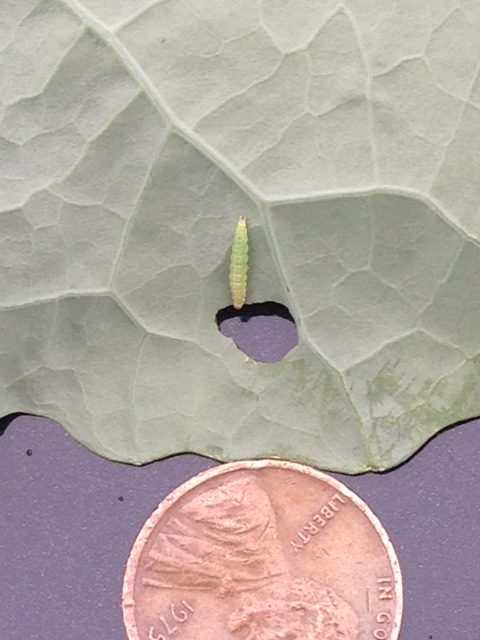 With fall plantings now underway, it is typical for diamondback moth larvae ((DBM) see photo at right) to become the dominant caterpillar pest in many cole crop fields. This pest can multiply quickly, with a generation completed in under 2 weeks with high temperatures. Furthermore, this pest is not responding to chlorantraniliprole (Coragen) in many parts of the state. Effective materials continue to be IRAC 5 materials (spinosyns), and the IRAC 6 material, ememectin benzoate (Proclaim). Consultants and scouts report good efficacy with the IRAC 21A, tolfenpyrad (Torac) . Be sure to check the Cole Crops Section of the 2022-23 Commercial Guide for specifics, as PHI’s and crop labels vary. It is important to return to treated fields within 2-3 days to assess the efficacy of the insecticide applications. Effective materials should eliminate DBM larvae within 48 hours.
With fall plantings now underway, it is typical for diamondback moth larvae ((DBM) see photo at right) to become the dominant caterpillar pest in many cole crop fields. This pest can multiply quickly, with a generation completed in under 2 weeks with high temperatures. Furthermore, this pest is not responding to chlorantraniliprole (Coragen) in many parts of the state. Effective materials continue to be IRAC 5 materials (spinosyns), and the IRAC 6 material, ememectin benzoate (Proclaim). Consultants and scouts report good efficacy with the IRAC 21A, tolfenpyrad (Torac) . Be sure to check the Cole Crops Section of the 2022-23 Commercial Guide for specifics, as PHI’s and crop labels vary. It is important to return to treated fields within 2-3 days to assess the efficacy of the insecticide applications. Effective materials should eliminate DBM larvae within 48 hours.
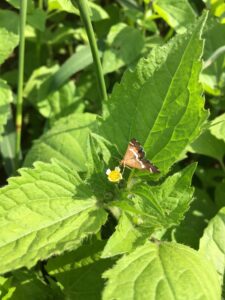 Recent farm visits in the northern half of the state have revealed high numbers of Hawaiian beet webworm (HBWW) moths in weedy areas (photo at left). Galinsoga patches seem to be favored by the moths. Injury to host crops (beet greens, swiss chard, spinach) has been reported from Middlesex County, and has been observed by IPM staff in Hunterdon County. Growers in all counties would be wise to check plantings of these hosts at least weekly for the presence of foliar injury. Numerous holes in leaves, with larvae on the lower leaf surfaces (photo at right). Recommended insecticides may be found in the Spinach Section of the 2022-23 Commercial Guide.
Recent farm visits in the northern half of the state have revealed high numbers of Hawaiian beet webworm (HBWW) moths in weedy areas (photo at left). Galinsoga patches seem to be favored by the moths. Injury to host crops (beet greens, swiss chard, spinach) has been reported from Middlesex County, and has been observed by IPM staff in Hunterdon County. Growers in all counties would be wise to check plantings of these hosts at least weekly for the presence of foliar injury. Numerous holes in leaves, with larvae on the lower leaf surfaces (photo at right). Recommended insecticides may be found in the Spinach Section of the 2022-23 Commercial Guide.
Beet Armyworm
Pheromone catches of beet armyworm are high in some southern NJ areas at this time. 148 moths per night in Woodstown and 7 per night in East Vineland have been reported. 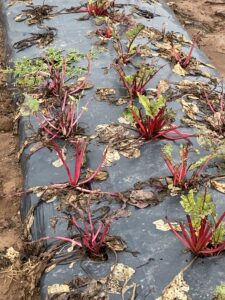
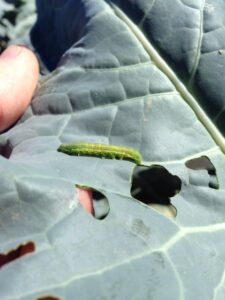 This pest (photo at near left) has the ability to defoliate pepper plants and damage fruit, and can cause severe damage on other crops (see photo of chard at far left). BAW is resistant to pyrethroid insecticides, and other materials should be used in response to infestations. Effective materials include spinosyns (IRAC 5) and diamides (IRAC 28).
This pest (photo at near left) has the ability to defoliate pepper plants and damage fruit, and can cause severe damage on other crops (see photo of chard at far left). BAW is resistant to pyrethroid insecticides, and other materials should be used in response to infestations. Effective materials include spinosyns (IRAC 5) and diamides (IRAC 28).
